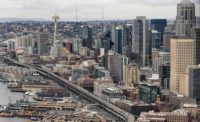Citing the recent Japanese earthquake, Seattle Mayor Mike McGinn (D) called for elected officials to reevaluate their decision to leave the seismically vulnerable Alaskan Way Viaduct (State Route 99) intact until 2016 as part of the deep-bore tunnel program schedule.
Ron Paananen, Wash. Dept. of Transportation viaduct program administer, couldn’t disagree more. Echoing sentiments of the majority of the Seattle City Council and Washington Gov. Chris Gregoire (D), Paananen says, “To simply close the viaduct without a reasonable replacement in place would be very damaging to the city of Seattle economically. To start over now and pursue a new alternative would delay the overall project schedule. The viaduct is just as vulnerable as it was before the earthquake in Japan.”
Work continues on the $3.1-billion project—not including an additional $1.1 billion in related improvements—to tear down the 2.2 miles of elevated roadway through Seattle’s waterfront and replace the southern mile with side-by-side roadway and improve 1.7 miles with a single-bore tunnel.
The Southern Mile
Led by New Jersey-based Skanska USA Civil, over 200 workers are actively resetting utilities, reconfiguring ramps that access the viaduct, conducting ground improvements and setting new foundations for the pre-stressed concrete girders for a bridge over Atlantic Street. When placed, the 205-ft.-long girders manufactured by Concrete Tech in Tacoma will be the longest precast girders in the state and the only major structure on the southern mile of the project, Paananen says.
Dan Howell, director of Northwest operations for Skanska, says beating early project milestones has been an exciting endeavor. “With the overall team relationship that has been developed between Skanska, WSDOT and the other stakeholders, we expect this project will be a huge success,” he says.
Howell’s team is prepping detours for the 2012 demolishing of the double-decker viaduct’s southern mile. The new roadway should open in 2013.
The Bored Tunnel
With the $1.09-billion construction contract for the $1.96-billion,1.7-mile bored tunnel project going to Seattle Tunnel Partners, comprising New York’s Dragados, the construction division of Spain’s ACS Group and Tutor Perini Corp. of Slymar, Calif., in January, the next big milestone is the final environmental impact statement, Paananen says. The EIS should be issued in mid-July and a record of decision in mid-August.
“Once we get the record of decision and the bored tunnel is cleared as the replacement, then we can issue notice to proceed number two to the design-builder,” he says. In that timetable, crews will mobilize as early as September.
The new 58-ft-dia single-bore tunnel—the largest of its kind in the world at present—will include 12,500 linear ft of new roadway, of which 9,273 will be constructed using a new earth pressure balance tunnel boring machine, says a Tutor Perini spokesperson. The tunnel will allow two lanes of traffic in each direction in a stacked configuration. The north end approach of 800 feet and the south end’s 2,400-foot approach will be constructed using cut-and-cover excavation and concrete placement methods.
Tunnel work will start by tying to Skanska’s work on the southern end, where geotechnical reports show soft soil eventually giving way to dense glacier-deposited soils. Preliminary work to design the boring machine is ongoing, but the contractor is restricted from ordering the machine until the record of decision is announced. Once ordered, it will take 16 to 18 months to deliver the machine, putting it on site in early 2013. Seattle Tunnel Partners has pledged to finish the tunnel in December 2015, allowing the viaduct to come down in early 2016.
Western Building
The latest twist in the tunnel project has the state now planning to spend $20 million to stabilize the 619 Western Building in Seattle’s famed Pioneer Square instead of demolishing it. Poor structural conditions and placement on unconsolidated fill put the building in danger during tunnel construction. Now, crews plan to install additional piles to support the foundation, stabilize existing structural elements and install temporary shoring and cabling inside the building. As an additional precaution, crews will construct a steel frame around the outside and inject stabilizing grouting in the soil.





